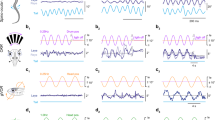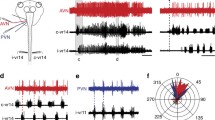Summary
We have investigated the sensory systems ofTriturus vulgaris embryos after they become capable of swimming. Reducing the light intensity produces no short latency response but leads to an increase in spontaneous movements not dependent on the lateral eyes. The pineal eye is implicated, and recordings show that it is excited by dimming. Mechanical stimulation of trunk skin evokes movements. The innervation of trunk skin by free nerve-endings from Rohon-Beard cells is demonstrated using horseradish peroxidase staining. Recordings from Rohon-Beard cells show their receptive fields. They respond to deformation of the skin. The embryos appear to lack a propagated skin impulse.
Similar content being viewed by others
References
Fan Shifan, Dai Rongxi (1962) Electric activity of embryonic epithelium in Urodeles. Kexuw Tongboa 10:38–9
Foster RG, Roberts A (1982) The pineal eye inXenopus laevis embryos and larvae:photoreceptors with a direct excitatory effect on behaviour. J Comp Physiol 145:413–419
Gallien L, Bidaud O (1959) Table chronologique du developpement chezTriturus helveticus Razoumowski. Bull Soc Zool Fr 84:22–32
Hayes BP, Roberts A (1983) The anatomy of two functional types of ‘free’ nerve ending in the head skin ofXenopus embryos. Proc R Soc Lond B 218:61–76
Hughes AFW (1957) The development of the primary sensory system inXenopus laevis. J Anat 91:323–338
Kelly DE (1971) Development aspects of amphibian pineal systems. In: Wolstenholme GE, Knight J (eds) The pineal gland. Churchill and Livingston, Edinburgh London
Roberts A (1971) The role of propagated skin impulses in the sensory system of young tadpoles. Z Vergl Physiol 75:388–401
Roberts A (1978) Pineal eye and behaviour inXenopus tadpoles. Nature 273:774
Roberts A (1980) The function and role of two types of mechanoreceptive ‘free’ nerve endings in the head skin of amphibian embryos. J Comp Physiol 135:341–348
Roberts A, Blight AR (1975) Anatomy, physiology and behavioural role of sensory nerve endings in the cement gland of embryonicXenopus. Proc R Soc Lond B 192:111–127
Roberts A, Clarke JDW (1982) The neuroanatomy of an amphibian embryo spinal cord. Phil Trans R Soc Lond B 296:195–212
Roberts A, Hayes BP (1977) The anatomy and function of ‘free’ nerve endings in an amphibian skin sensory system. Proc R Soc Lond B 196:415–429
Roberts A, Smyth D (1974) The development of a dual touch sensory system in embryos of the amphibianXenopus laevis. J Comp Physiol 88:31–42
Roberts A, Stirling CA (1971) The properties and propagation of a cardiac-like impulse in the skin of young tadpoles. Z Vergl Physiol 71:295–310
Sato E, Adachi S, Ito S (1981) The genesis and transmission of epidermal potentials in an amphibian embryo. Dev Biol 88:137–146
Soffe SR, Clarke JDW, Roberts A (1983) Swimming and other centrally generated motor patterns in newt embryos. J Comp Physiol 152:535–544
Sun Yian, Dai Rongxi (1982) Further studies on the electrical activity of epithelial cells in embryos ofCynops orientalis. Acta Biol Exp Sinica 15:351–359
Wintrebert P (1904) Sur l'existence d'une irritabilité excitomotrice primitive independante de voies nerveuses chez les embryons ciliés des batraciens. CR Soc Biol Paris 57:645–647
Author information
Authors and Affiliations
Rights and permissions
About this article
Cite this article
Roberts, A., Clarke, J.D.W. The sensory systems of embryos of the newt:Triturus vulgaris . J. Comp. Physiol. 152, 529–534 (1983). https://doi.org/10.1007/BF00606442
Accepted:
Issue Date:
DOI: https://doi.org/10.1007/BF00606442




